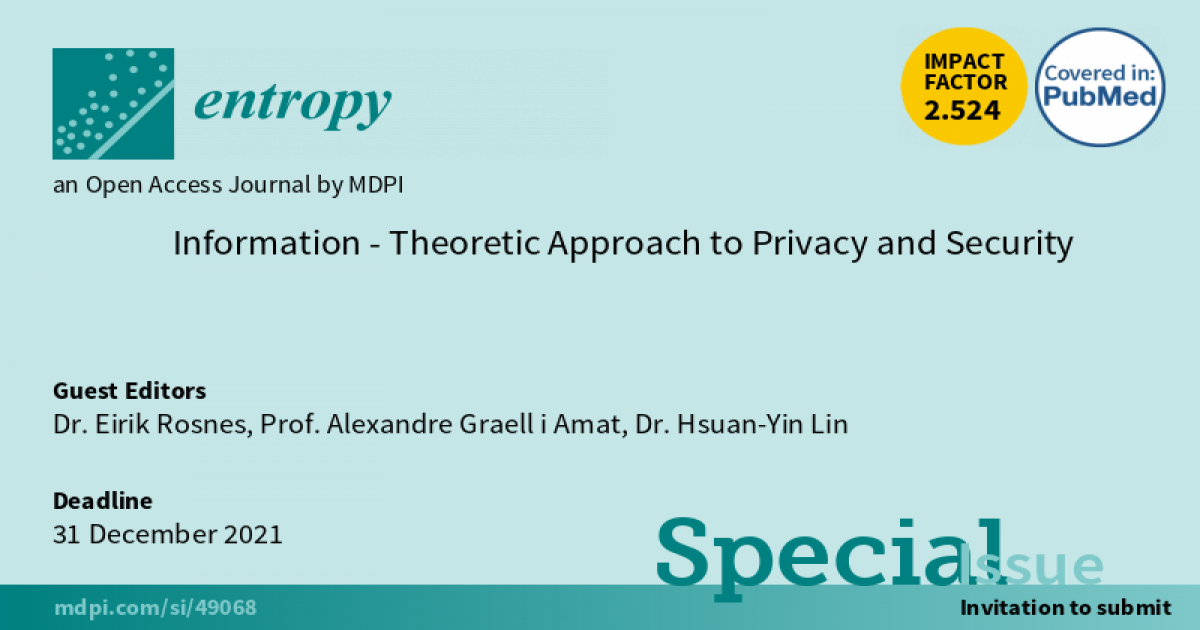Information-Theoretic Approach to Privacy and Security
A special issue of Entropy (ISSN 1099-4300). This special issue belongs to the section "Information Theory, Probability and Statistics".
Deadline for manuscript submissions: closed (31 December 2021) | Viewed by 18354

Special Issue Editors
Interests: information and coding theory and their applications to distributed storage and computing, privacy, and security
Special Issues, Collections and Topics in MDPI journals
Interests: coding theory and its application to distributed storage and computing, privacy, and optical communications
Special Issues, Collections and Topics in MDPI journals
Interests: information and coding theory; with applications to privacy; security; statistical machine learning; distributed storage; networking; finite blocklength communications
Special Issues, Collections and Topics in MDPI journals
Special Issue Information
Dear Colleagues,
Information theory provides an alternative approach to computational-based methods to address important security and privacy issues in modern distributed information systems. In contrast to computational-based methods, an information-theoretic approach offers unconditional (or perfect) security and privacy guarantees without relying on the hardness of certain computational problems, i.e., the system cannot be broken even if the adversary has unlimited computing power. The approach dates back to the work of Shannon, and the literature on the topic is vast. There are a variety of security tasks for which information-theoretic security is a meaningful and useful requirement, such as secret sharing, secure multiparty computation, and private information retrieval. Today, this a very active research area within the information theory, cryptography, and computer science communities. Despite many recent advances in the area, however, important research problems still remain open—for instance, within new emerging technologies such as the Internet of Things (IoT), edge caching/computing in 5G wireless networks, and machine learning, which impose serious security and privacy challenges.
This Special Issue invites submissions of high-quality original technical and survey papers in this very vibrant area addressing both the theoretical and practical aspects of information-theoretic security and privacy, hopefully inspiring researchers to identify practical use cases.
Dr. Eirik Rosnes
Prof. Alexandre Graell i Amat
Dr. Hsuan-Yin Lin
Guest Editors
Manuscript Submission Information
Manuscripts should be submitted online at www.mdpi.com by registering and logging in to this website. Once you are registered, click here to go to the submission form. Manuscripts can be submitted until the deadline. All submissions that pass pre-check are peer-reviewed. Accepted papers will be published continuously in the journal (as soon as accepted) and will be listed together on the special issue website. Research articles, review articles as well as short communications are invited. For planned papers, a title and short abstract (about 100 words) can be sent to the Editorial Office for announcement on this website.
Submitted manuscripts should not have been published previously, nor be under consideration for publication elsewhere (except conference proceedings papers). All manuscripts are thoroughly refereed through a single-blind peer-review process. A guide for authors and other relevant information for submission of manuscripts is available on the Instructions for Authors page. Entropy is an international peer-reviewed open access monthly journal published by MDPI.
Please visit the Instructions for Authors page before submitting a manuscript. The Article Processing Charge (APC) for publication in this open access journal is 2600 CHF (Swiss Francs). Submitted papers should be well formatted and use good English. Authors may use MDPI's English editing service prior to publication or during author revisions.
Keywords
- Secure and private distributed/edge/fog/cloud computing
- User privacy guarantees in IoT and edge caching
- Private information retrieval and private computation
- Secret sharing and secure multiparty computation
- Information-theoretic notions of privacy
- Differential privacy: theory, applications, and implementations
- Privacy-preserving machine learning and federated learning
- Trade-offs between privacy/fairness and utility
- Generative adversarial privacy
- Physical-layer information-theoretic security
- Covert communications
- Practical applications of information-theoretic security and privacy








